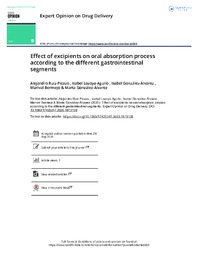Please use this identifier to cite or link to this item:
https://hdl.handle.net/11000/35119Full metadata record
| DC Field | Value | Language |
|---|---|---|
| dc.contributor.author | Ruiz Picazo, Alejandro | - |
| dc.contributor.author | Lozoya-Agullo, Isabel | - |
| dc.contributor.author | González-Álvarez, Isabel | - |
| dc.contributor.author | Bermejo, Marival | - |
| dc.contributor.author | González-Álvarez, Marta | - |
| dc.contributor.other | Departamentos de la UMH::Ingeniería | es_ES |
| dc.date.accessioned | 2025-01-22T09:20:52Z | - |
| dc.date.available | 2025-01-22T09:20:52Z | - |
| dc.date.created | 2020-08 | - |
| dc.identifier.citation | Expert Opinion on Drug Delivery, 2020 | es_ES |
| dc.identifier.issn | 1744-7593 | - |
| dc.identifier.issn | 1742-5247 | - |
| dc.identifier.uri | https://hdl.handle.net/11000/35119 | - |
| dc.description.abstract | Introduction: Excipients are necessary to develop oral dosage forms of any Active Pharmaceutical Ingredient (API). Traditionally, excipients have been considered inactive and inert substances, but, over the years, numerous studies have contradicted this belief. This review focuses on the effect of excipients on the physiological variables affecting oral absorption along the different segments of the gastrointestinal tract. The effect of excipients on the segmental absorption variables are illustrated with examples to help understand the complexity of predicting their in vivo effects. Areas covered: The effects of excipients on disintegration, solubility and dissolution, transit time and absorption are analysed in the context of the different gastrointestinal segments and the physiological factors affecting release and membrane permeation. The experimental techniques used to study excipient effects and their human predictive ability are reviewed. Expert opinion: The observed effects of excipient in oral absorption process have been characterized in the past, mainly in vitro (i.e. in dissolution studies, in vitro cell culture methods or in situ animal studies). Unfortunately, a clear link with their effects in vivo i.e. their impact on Cmax or AUC, which need a mechanistic approach is still missing. The information compiled in this review leads to the conclusion that the effect of excipients in API oral absorption and bioavailability is undeniable and shows the need of implementing standardized and reproducible preclinical tools coupled with mechanistic and predictive physiological based models to improve the current empirical retrospective approach. | es_ES |
| dc.format | application/pdf | es_ES |
| dc.format.extent | 72 | es_ES |
| dc.language.iso | eng | es_ES |
| dc.publisher | Taylor and Francis Group | es_ES |
| dc.rights | info:eu-repo/semantics/openAccess | es_ES |
| dc.rights | Attribution-NonCommercial-NoDerivatives 4.0 Internacional | * |
| dc.rights.uri | http://creativecommons.org/licenses/by-nc-nd/4.0/ | * |
| dc.subject | Biopharmaceutical Classification System of Excipients | es_ES |
| dc.subject | Excipient | es_ES |
| dc.subject | Gastrointestinal segments | es_ES |
| dc.subject | Oral Absorption | es_ES |
| dc.subject.other | CDU::6 - Ciencias aplicadas::62 - Ingeniería. Tecnología | es_ES |
| dc.title | Effect of excipients on oral absorption process according to the different gastrointestinal segments | es_ES |
| dc.type | info:eu-repo/semantics/article | es_ES |
| dc.relation.publisherversion | https://doi.org/10.1080/17425247.2020.1813108 | es_ES |

View/Open:
4 Effect of excipients on oral absorption process (1).pdf
794,24 kB
Adobe PDF
Share:
.png)
